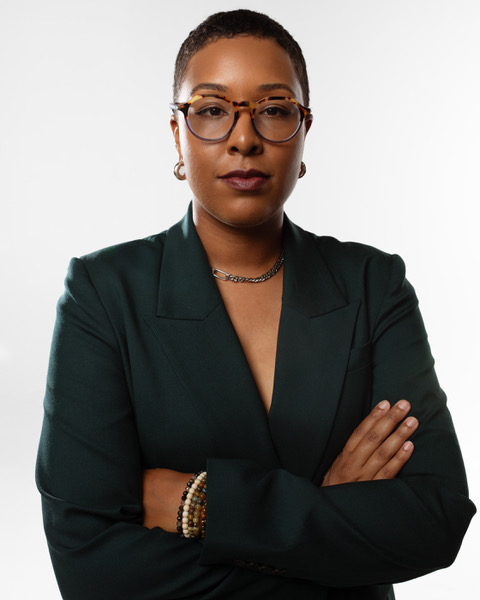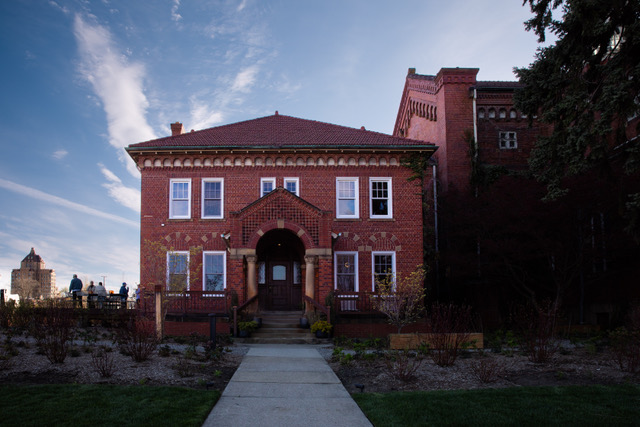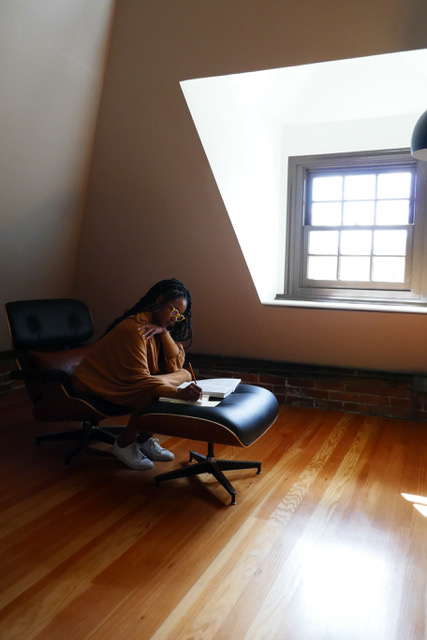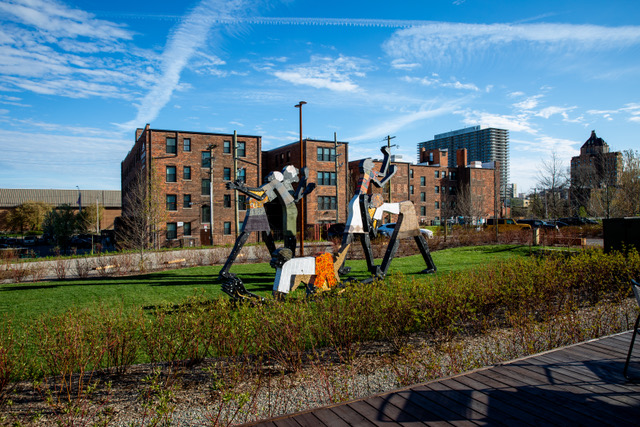Recently I had the opportunity to visit Detroit for the first time in my life. What a magnificently diverse city bustling with bars and restaurants on every corner in the downtown area, with one of the top encyclopedic art museums in the nation where the socialist mural by Diego Rivera can be seen.
No wonder Taylor Renee Aldridge left Los Angeles to return to her native Detroit, I thought to myself as I was tooling around downtown in the brisk autumn weather. It was early evening when I arrived, and the city was abuzz with long lines for dining and people spilling in and out of bars. After losing over a million of their population, the city is having a bit of a renaissance. Just 15 minutes away, the burgeoning Little Village arts district is where Aldridge serves as executive director of the Modern Ancient Brown Foundation (MABF).

Taylor Renee Aldridge. Photo: Bella Lopez.
Before packing her belongings and her two schnauzers for a cross-country road trip with her partner back to Detroit, Aldridge resided in Los Angeles as the visual arts curator and program manager at the California African American Museum (CAAM) for four years. One of the exhibitions she worked on featuring the works of artist Simone Leigh is still on view at CAAM and the Los Angeles County Museum of Art. Besides reuniting with family and friends, Aldridge stated another motive for returning to her hometown was, curiously enough, climate change. “Being in middle America, surrounded by the Great Lakes and having affordable housing,” she noted, “and to be rooted somewhere,” all made the decision to return an easy one.
I met Aldridge for a sit-down interview to discuss her new position at MABF and what her goals might be. Dressed in a casual pantsuit of neutral colors and sensible shoes, the bespectacled Aldridge is soft-spoken and deliberate with her words and surprisingly young for all her accomplishments in the art world thus far—she is only 34 years old.

The Shepherd. Photo: Katie Greenstone.
Located on the third floor in the arts complex called The Shepherd, MABF was founded in 2019 by Detroit-native, Chicago-based veteran AbEx painter McArthur Binion, offering residencies and fellowships to the BIPOC (Black, Indigenous, and People of Color) community. The Shepherd, a 110-year-old repurposed church, is the star of the Little Village development, providing a public library, art galleries, and performance spaces. Besides hosting MABF, it is a community-based cultural center where every room has been meticulously and tastefully restored, including a room where Mass was once held—I almost slipped into a confessional booth; I could hear Father calling! The building became an arts complex when real estate moguls and gallerists Anthony & JJ Curis purchased the grand church on a more than three-acre campus, including a skateboard park and numerous public sculptures, complete with rectory and, soon, a local bar!

Residency Space. Photo: Kyle Powell.
MABF offers four-month off-campus residencies to post-bachelor artists. Aldridge expressed that this time for artists can be especially daunting as many people rush into their masters, “People are under so much pressure to produce and keep going and constantly having to figure out how to make a living. That pulls people away from being creative, and creativity requires imagination, requires freedom of thought, requires leisure, reading, exchange of ideas. And I don’t feel that artists are getting that,” Aldridge explained. “It’s my hope that they can come through this foundation and feel free to just … imagine.” The residency provides a stipend that makes it possible for artists not to have to work during that period.
Fellowships are granted to the more seasoned scholar and last for three weeks. “For someone in art history, or comparative literature, some sort of advanced study, we accept all scholars who are engaging in the PhD process,” Aldridge told me. She would also like to see a “cross-collaborative exchange and cross-pollination, in theory, between scholars and visual artists. That’s one of my goals in developing that two-pronged offering.”

Fellowship Space. Photo: Katie Greenstone.
To be fair, Aldridge had only been in her position for three weeks when we met, but she exudes confidence and articulates her intentions impressively. For instance, when I asked if MABF would include seminars and panel discussions for the arts community, she replied in the affirmative and plans to do some experimenting with the traditional platform. “It’s a matter of collaboration; I want to play with the form of a lecture because that can get a little boring,” she admitted with a slight titter.
Making sure that she’s of service to the artists within the program, but also artists within the city of Detroit, is one of Aldridge’s visions in her new role at MABF. “There’s a wide range we accept, a number of different types of scholars, particularly people who may be attending to BIPOC and Queer discourse,” she said. She wants to specifically target people who may not have access to an MFA program or may not even have access to a community of writers and other artists who can provide feedback. “I’m interested in getting to the basics of what are the ways in which we can grow artists’ practices here,” she said. “How can we connect them with gallerists, with seasoned people in the field so they may figure out ways to sell their artwork or grow their practice; those really tangible needs.”
Aldridge talked about her experience growing up in Detroit and how she got turned on to the arts when her grade school teacher introduced her to the Black female artist Lois Mailou Jones. She got hooked on art, and was thrilled to know that people can make a living doing art. Then her high school teacher gave her a book on Clement Greenberg and she started to read about criticism, “And I thought, oh, so you can make art and then there’s all this discourse that can happen around your art or in conversation with art, and that was just really interesting to me as a young person, and someone who is just really interested in dialogical exchange and people learning from each other.” She added with a laugh that we have a lot of critiques about Clement Greenberg—now that we’ve evolved!
Her interest and discovery involve other aspects of the art world and she wants to share her knowledge on how the art market functions. “I’m thinking about those people as a particular audience, who may want to know more but don’t know where to begin,” she said, adding that she’d like to bring peers and colleagues to the city who are successful in the art industry and those administrative positions. “Demystify the pipeline” is one motive she’d like to accomplish. “Like, how do you become a curator, how do you become a scholar, how do you become an artist?”
For more information: https://www.modernancientbrown.com; For information on Fellowship applications: https://www.modernancientbrown.com/the-fellowship-application; For information of Residencies: https://www.modernancientbrown.com/post-bac-artist-residency-application


